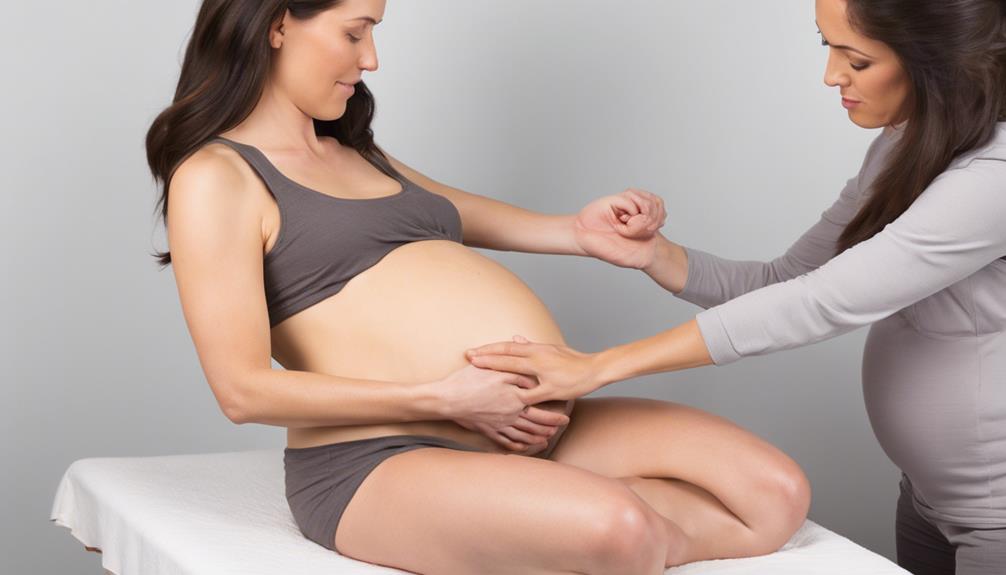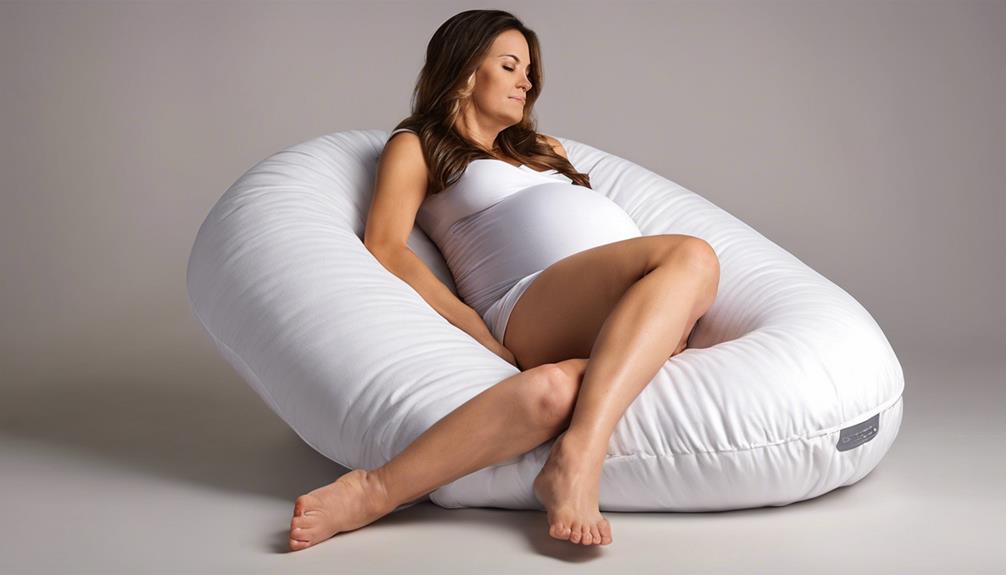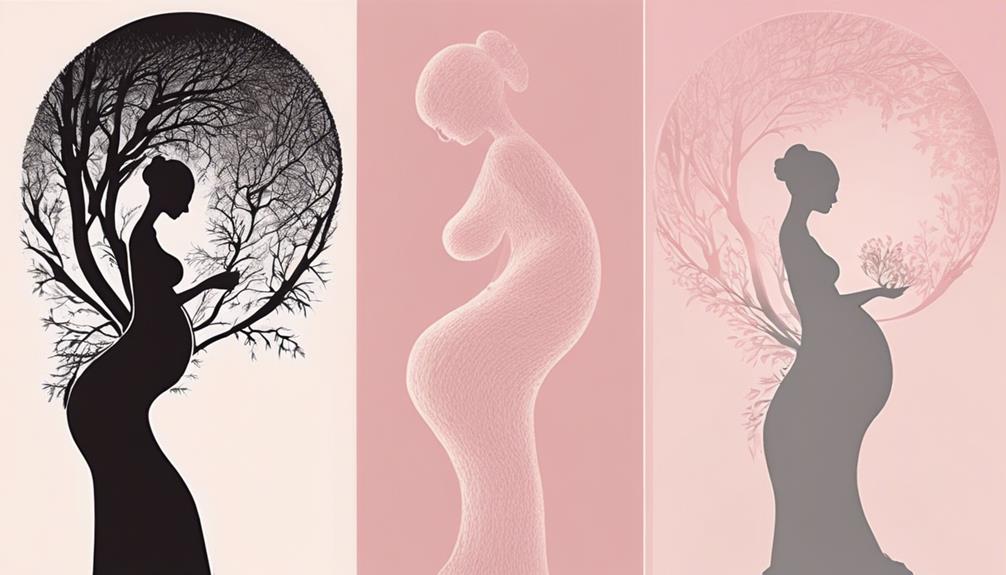Let’s unravel the complexity of dealing with cramps in the second trimester of pregnancy. Managing these pains can greatly improve the experience for many expectant mothers.
From practical tips like changing positions and applying heat, to more proactive measures such as communication with healthcare providers, exploring this phase requires attention and care.
But what about those lesser-known strategies that could make all the difference?
Key Takeaways
- Stay hydrated with water and water-rich foods to prevent cramps.
- Maintain good posture and use supportive measures for comfort.
- Engage in gentle exercises and activities suitable for pregnancy.
- Use heat and cold therapy under healthcare provider guidance for relief.
Stay Hydrated
Staying hydrated plays an important role in managing cramping during the second trimester of pregnancy. Dehydration can exacerbate cramps, making it critical to drink at least 8 cups of water daily. Proper hydration not only helps prevent cramps but also guarantees the body receives essential nutrients essential for a healthy pregnancy. We recommend incorporating water-rich foods like cauliflower and spinach into your diet to aid in hydration.
During pregnancy, it's common to experience muscle cramps due to the body's increased demand for fluids. By sipping water throughout the day, you can maintain hydration levels and reduce the risk of cramps. This simple yet effective practice can make a significant difference in how you feel during the second trimester. Remember, your body is working hard to nurture your growing baby, so prioritizing hydration is key to a more comfortable pregnancy experience.
Maintain Proper Posture

To alleviate cramping during the second trimester of pregnancy, maintaining proper posture is important for reducing strain on muscles and ligaments. Here are some tips to help you maintain good posture and reduce cramping:
- Avoid Slouching: Keep your back straight and avoid arching it to support your growing belly and prevent strain on muscles and ligaments.
- Sit with Support: Choose a chair with good lumbar support or use a pillow behind your lower back to maintain a neutral spine position and minimize pressure on your lower back and pelvis.
- Practice Pelvic Tilts: Engage in pelvic tilts and gentle stretches to strengthen your core muscles, improve posture, and alleviate cramping in the second trimester.
- Stay Relaxed: Sit with your shoulders relaxed to prevent tension build-up in your upper body and reduce the risk of muscle cramps.
Practice Gentle Exercises
Engaging in gentle exercises such as prenatal yoga and swimming can effectively alleviate cramping during the second trimester of pregnancy. These low-impact activities can improve circulation, reduce muscle tension, and provide much-needed relief from cramps.
Prioritizing gentle movements that support your pregnant body's changes and avoiding high-impact or strenuous workouts that could exacerbate discomfort is important. Consulting your healthcare provider or a prenatal fitness specialist for personalized exercise recommendations is vital to make sure you're engaging in safe and beneficial activities.
Apply Heat or Cold Packs

When experiencing cramping during the second trimester of pregnancy, using heat or cold packs can be an important way to alleviate discomfort and relax muscles. Here are some important points to take into account when applying heat or cold packs for cramping relief:
- Heat Therapy: Applying a warm compress or heating pad can help increase blood flow to the cramping area, easing pain and promoting muscle relaxation.
- Cold Packs: Cold packs or ice packs can be effective in numbing the area and reducing inflammation associated with cramping, offering a cooling relief.
- Alternating Therapy: Alternating between heat and cold therapy may provide additional relief for persistent or severe cramps in the second trimester, offering a thorough approach to managing discomfort.
- Consultation: It's essential to consult with your healthcare provider before using heat or cold packs to make sure they're safe and suitable for your individual situation during pregnancy. Your provider can offer personalized guidance and guarantee the best care for you and your baby.
Wear Supportive Clothing
Navigating cramping discomfort in the second trimester of pregnancy can be alleviated by selecting supportive clothing options that cater to your changing body's needs. Maternity clothes with supportive belly bands can help alleviate pressure on the abdomen, reducing cramping sensations.
Opt for low-heeled shoes to provide the necessary support to prevent posture issues and additional strain on your muscles. Consider wearing compression socks made from breathable fabric to enhance circulation, reducing swelling in the legs often associated with cramps.
A pregnancy support belt can provide extra support to the lower back and pelvis, helping to minimize discomfort. Make sure your clothing is comfortable and allows for movement, as restrictive clothing can worsen cramping episodes.
Consider Prenatal Massages

Considering the benefits of prenatal massages for reducing muscle tension and promoting relaxation during the second trimester of pregnancy is a wise choice for expecting mothers seeking relief. Prenatal massages offer a safe and effective way to address the specific needs and comfort levels of pregnant women, providing a range of benefits beyond just relaxation. Here are some reasons why incorporating prenatal massages into your routine can be incredibly beneficial:
- Tailored Techniques: Prenatal massage therapists are trained to use techniques that aren't only safe but also specifically catered to the needs of pregnant individuals.
- Improved Circulation: These massages can help improve blood flow, benefiting both the mother and the baby.
- Reduced Stress: Expecting mothers often experience heightened stress levels, and prenatal massages can be a soothing way to alleviate some of that tension.
- Relief from Discomfort: From back pain to swollen ankles, prenatal massages can provide much-needed relief from common pregnancy discomforts.
Incorporate Relaxation Techniques

Exploring various relaxation techniques can greatly aid in managing cramping discomforts experienced during the second trimester of pregnancy. Techniques such as muscle relaxation, prenatal yoga, mindfulness, gentle stretching, stress reduction, and self-care play an important role in alleviating cramps.
Deep breathing and progressive muscle relaxation techniques can help ease muscle tension, while mindfulness, meditation, and guided imagery can reduce stress levels, potentially minimizing cramps. Engaging in regular prenatal yoga sessions or gentle stretching routines can promote muscle flexibility and relaxation, contributing to cramp management.
Additionally, activities like listening to soothing music, taking warm baths, and light exercises such as walking or swimming can foster a calmer state, potentially reducing cramping discomfort. Prioritizing adequate rest, dedicating time for self-care, and creating a peaceful environment are essential for enhancing relaxation and possibly decreasing the frequency of cramps in the second trimester of pregnancy.
Monitor Your Diet

Let's prioritize balanced nutrition choices and staying hydrated to alleviate cramping during your second trimester.
Including magnesium-rich foods like nuts and leafy greens, along with potassium sources such as bananas and avocados, can support muscle function and reduce the risk of cramps.
Remember to hydrate effectively with water and foods like watermelon and cucumbers, avoiding excessive caffeine intake that can lead to dehydration and muscle cramping.
Balanced Nutrition Choices
To maintain peak muscle function and minimize the occurrence of cramping during your second trimester of pregnancy, prioritize incorporating a variety of nutrient-rich foods into your daily meals. Here are some essential nutrition choices to keep in mind:
- Include calcium, magnesium, and potassium-rich foods like leafy greens, dairy products, nuts, seeds, and whole grains in your diet.
- Limit caffeine and processed foods to bear in mind dehydration and muscle cramping.
- Stay hydrated by drinking plenty of water throughout the day to prevent exacerbating muscle cramps.
- Seek guidance from healthcare providers or nutritionists to develop a personalized pregnancy diet plan that supports muscle function and reduces cramping risk.
Ensuring a well-balanced diet can play a significant role in managing muscle cramps during pregnancy.
Hydration for Cramp Relief
Maintaining proper hydration levels through adequate water intake is crucial for relieving and preventing cramping during the second trimester of pregnancy. Dehydration can exacerbate cramps, so it's crucial to drink at least 8 cups of water daily.
Incorporating water-rich foods like cauliflower and spinach into your diet can help prevent cramps by providing hydration and essential nutrients. Sipping water consistently throughout the day supports hydration levels and reduces the likelihood of experiencing cramps.
Proper hydration not only aids in preventing cramps but also promotes overall health and well-being during pregnancy. Remember, staying adequately hydrated is a simple yet effective way to manage and prevent cramping in the second trimester.
Use Pregnancy Pillows

During the second trimester of pregnancy, incorporating a pregnancy pillow can greatly enhance comfort and support for the belly, back, and hips. Here's why pregnancy pillows are a must-have for managing cramping and discomfort:
- Support where you need it: Pregnancy pillows are designed to provide targeted support to areas like the lower back, pelvis, and belly, helping alleviate pressure and promoting better alignment while you sleep.
- Improved sleeping positions: By using a pregnancy pillow, you can more easily find comfortable sleeping positions that relieve strain on your muscles and joints, reducing discomfort and the likelihood of cramping.
- Enhanced quality of sleep: With the added support and comfort that pregnancy pillows offer, you can enjoy better sleep quality, especially as your belly grows larger and traditional sleeping positions become less feasible.
- Personalized comfort: Pregnancy pillows come in various shapes and sizes, allowing you to choose one that suits your preferences and provides the right level of support for a restful night's sleep.
Investing in a quality pregnancy pillow can make a significant difference in how you experience cramping and discomfort during the second trimester, ultimately leading to better rest and well-being.
Communicate With Your Healthcare Provider

When addressing cramping concerns during pregnancy, initiating open communication with your healthcare provider is essential. Discussing your cramping concerns with your healthcare provider allows for the opportunity to rule out serious conditions such as ectopic pregnancy or preterm labor.
Your provider can offer personalized advice tailored to managing cramps specifically during the second trimester of your pregnancy. It's important to keep your healthcare provider informed about the frequency, intensity, and duration of your cramping episodes for a proper evaluation.
Seeking guidance from your provider on when to seek medical attention for cramping and related symptoms is crucial during this stage of pregnancy. By maintaining open communication with your healthcare provider, you can receive recommendations on specific remedies, exercises, or interventions to effectively alleviate cramping discomfort.
Frequently Asked Questions
How Can I Stop Cramping in My Second Trimester?
To stop cramping in the second trimester, we suggest gentle stretching, staying hydrated, including magnesium-rich foods, maintaining good posture, and using warm compresses. These methods can help alleviate discomfort and promote muscle relaxation during pregnancy.
Is Cramping All Day Normal in Second Trimester?
Yes, cramping all day in the second trimester can be normal as the uterus expands and ligaments stretch. Increased activity can heighten awareness of cramping. Monitoring patterns and symptoms is essential for reassurance and peace of mind.
How Can I Make My Pregnancy Cramps Hurt Less?
To make pregnancy cramps hurt less, we suggest deep breathing, staying hydrated, using a pregnancy support belt, warm baths, and gentle exercises like prenatal yoga. These techniques can help relax muscles and alleviate discomfort during the second trimester.
What Helps Stomach Cramps During Pregnancy?
We find that staying hydrated, practicing deep breathing, and engaging in gentle exercises can help relieve stomach cramps during pregnancy. Small, frequent meals and warm compresses may also provide relief. Prioritizing self-care during this time is crucial.
Conclusion
As we journey through the second trimester of pregnancy, managing cramping becomes a priority. Just like a ship steering through rough waters, we must adjust our sails and stay vigilant.
By staying hydrated, practicing gentle exercises, and communicating with our healthcare providers, we can steer through the discomfort and emerge stronger.
Remember, we're the captains of our own ship, guiding ourselves through each wave with grace and resilience.










